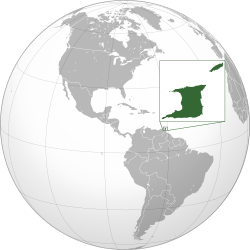Moluscos no marinos de Trinidad y Tobago
Apariencia

Por moluscos no marinos de Trinidad y Tobago se entiende la parte de la malacofauna de las islas antillanas Trinidad y Tobago que habitan en agua dulce y en el medio terrestre y está constituida por caracoles, almejas y mejillones que viven en hábitats de agua dulce, y los caracoles y babosas que viven en la tierra.
Antecedente[editar]
A partir de la década de 1860, los moluscos terrestres y de agua dulce de Trinidad y Tobago han sido bastante bien estudiado. Thomas Bland publicó el primer documento menciona los moluscos terrestres en 1861.[1] Robert John Lechmere Guppy descubrió e identificó muchas más especies a partir de 1864[2][3] en adelante y junto con Edgar Albert Smith fueron los responsables de las primeras listas completas de especies.
Listado de especies de Trinidad y Tobago[editar]
Gastrópodos de agua dulce[editar]




- Marisa cornuarietis (Linnaeus, 1758)[4][5]
- Pomacea glauca (Linné, 1758)[4][5]
- Pomacea urceus (Müller, 1774)[4][5]
- Hebetancylus excentricus (Morelet, 1851)[6]
- Pyrgophorus parvulus (Guilding, 1828)[6]
- Physella cubensis (Pfeiffer, 1839)[6]
- Tropicorbis pallidus (C.B. Adams, 1846)[6]
- Melanoides tuberculata (O. F. Müller, 1774)[7]
Gastrópodos terrestres[editar]
- Helicina nemoralis Guppy, 1866[4]
- Helicina dysoni (L. Pfeiffer, 1849)[4]
- Lucidella ignicoma (Guppy, 1868)[4]
- Lucidella lirata (L. Pfeiffer, 1847)[4]
- Cyclohidalgoa translucidum - Cyclohidalgoa translucidum trinitense (Guppy, 1864)[4]
- Austrocyclotus rugatus (Guppy, 1864)[4]

- Adelopoma occidentale (Guppy, 1872)[4]
- Choanopoma aripensis (Guppy, 1864)[4]
- Blandiella reclusa Guppy, 1871[4]
- Diplosolenodea bielenbergi (Semper, 1885)
- Sarasinula plebeia (Fischer, 1868)

- Allopeas gracile (Hutton, 1834)
- Allopeas micra (d’Orbigny, 1835)[4]
- Beckianum beckianum (L. Pfeiffer, 1846)[4]
- Leptinaria simplex (Guppy, 1868)[4]
- Leptinaria unilamellata (d’Orbigny, 1837)[4]
- Leptinaria urichi (E.A. Smith, 1896)[4]
- Obeliscus plicatellum (Guppy, 1868)[4]
- Subulina octona (Bruguière, 1798)[4]
- Karolus consobrinus (d’Orbigny, 1842)[4]

- Huttonella bicolor (Hutton, 1834)[4]
- Streptaxis glaber (L. Pfeiffer, 1849)[4]
- Streptostele musaecola (Morelet, 1860)
- Succinea candeana Lea
- Succinea pusilla Pfeiffer
- Omalonyx matheroni (Potiez & Michaud, 1838)[4]
- Bothriopupa tenuidens (C.B. Adams, 1845)[8]
- Gastrocopta barbadensis (L. Pfeiffer, 1853)[4]
- Gastrocopta servilis riisei (L. Pfeiffer, 1852)[8]
- Gastrocopta rupicola marginalba (L. Pfeiffer, 1840)[8]
- Gastrocopta geminidens (Pilsbry, 1930)[8]

- Orthalicus undatus (Bruguière, 1792)[4]
- Bulimulus diaphanus (Pfeiffer, 1855)
- Drymaeus broadwayi (E.A. Smith, 1896)[4]
- Drymaeus imperfectus (Guppy, 1866)
- Drymaeus mossi (E.A. Smith, 1896)[4]
- Drymaeus rawsoni (Guppy, 1871)[4]
- Drymaeus vincentinus (L. Pfeiffer, 1846)[4]
- Naesiotus pilosus (Guppy, 1871)[4]
- Plekocheilus glaber (Gmelin, 1791)[4]
- Simpulopsis corrugatus Guppy, 1866
- Brachypodella trinitaria (L. Pfeiffer, 1860)[4]
- Brachypodella oropuchensis Spence
- Happiella guildingi (Bland, 1865)[4]
- Miradiscops lunti (E.A. Smith, 1898)
- Systrophia alicea (Guppy, 1871)[4]
- Tamayoa trinitaria (E.A. Smith, 1898)


- Striatura umbratilis (Guppy, 1868)[4]
- Pallifera sp.
- Guppya gundlachi (L. Pfeiffer, 1840)
- Habroconus ernsti (Jousseaume)
- Habroconus cassiquiensis (L. Pfeiffer, 1853)[4]
- Ovachlamys fulgens (Gude, 1900)
- Megalobulimus oblongus (Müller, 1774)[4]
- Megalobulimus oblongus var. tobagoensis (Pilsbry, 1895)
- Radiodiscus bactricolus (Guppy, 1868)[4]
- Averellia coactiliata (Deshayes, 1839)[4]
- Thysanophora plagioptycha (Shuttleworth, 1854)
Freshwater bivalves[editar]

- Anodontites leotaudi (Guppy, 1864)[4]
- Mycetopoda siliquosa (Spix, 1827)[9]
- Pisidium punctiferum (Guppy, 1867)[10]
- Eupera cubensis (Prime, 1865)[6]
Véase también[editar]
- Anexo:Escorpiones de Trinidad y Tobago
- Anexo:Moluscos no marinos de Guadalupe
- Moluscos no marinos de Venezuela
- Moluscos del Estado Falcón
- Anexo:Moluscos del Municipio El Hatillo
- Moluscos introducidos en Venezuela
- Anexo:Fauna del Golfo de Venezuela
Referencias[editar]
- ↑ Bland T. (1861): On the Geographical Distribution of the Genera and Species of Land Shells of the West India Islands with a Catalogue of the species of each island. The Annals of The Lyceum of Natural History, New York. Vol. VII.
- ↑ Guppy, R. J. L. (1868). "On the terrestrial mollusks of Dominica and Grenada, with an account of some new species from Trinidad". Annals and Magazine of Natural History 1 (4): 429–442. [1]
- ↑ Guppy, R. J. L. (1872). Third series of additions to the Catalogue of the land and freshwater Molluska of Trinidad: with a revised list of all the species.
- ↑ a b c d e f g h i j k l m n ñ o p q r s t u v w x y z aa ab ac ad ae af ag ah ai aj ak al am Smith E.A. (1896) A List of the Land and Freshwater Mollusca of Trinidad. Journal of Conchlogy 8:231-251.
- ↑ a b c Geijkes, D.C. & Pain, T. (1957): Suriname freshwater snail of the genus Pomacea. Studies on the Fauna of Suriname and others Guyanas, 1(3):41-48 pt.IX-X.
- ↑ a b c d e Bass D. (2003) A Survey of Freshwater Macroinvertebrates in Tobago. The Living World Journal 2003:64-68.
- ↑ Bacon P.R. (1978) Notes on some freshwater molluscs from Nariva Swamp, Trinidad. The Living World Journal 1978:14-15.
- ↑ a b c d Haas F. (1960) Caribbean Land Molluscs: Vertiginidae. Studies on the Fauna of Curaçao and other Caribbean Islands. 10:1-17.
- ↑ Mohammed R.S., Nieweg D.C., Rostant W.G. and Badal P (2008) Collections of Freshwater mussel shells of Anodontites sp. and Mycetopoda sp. in rivers of south-central Trinidad, West Indies. The Living World Journal 2008:76-77.
- ↑ Guppy R. J. L. (1867). "Description of a new freshwater bivalve found in Trinidad" Annals and Magazine of Natural History (3)19(111): 160-161.
